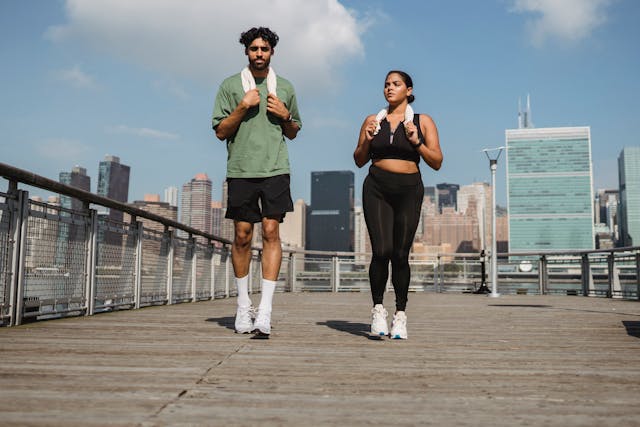Summer heat can take a toll on your health and wellness. Stay safe and fit, no matter what the thermometer says, with these hot tips.
Heatstroke dangers
“Never ignore heat exposure symptoms,” says Joseph Sudimack, MS, CSCS. “There’s an increased risk of having something mild, such as muscular cramps, or [something more severe like a] life-threatening event [such as] heatstroke.
“Heat-related muscular cramps are characterized by the muscle contracting involuntarily, with dehydration and electrolyte imbalance being the likely culprit,” Sudimack explains. “If your core temperature exceeds 40 C (104 F), you’re at risk of heatstroke.
Heatstroke symptoms
- confusion
- irritability
- profuse sweating
- increased heart rate
- fatigue
- nausea
- vomiting
6 tips to heat-proof your summer workout
“It’s easy to over-tax your body when temperatures are high,” warns personal trainer Jack Craig. Thankfully, you can build your summer body without succumbing to summer heat.
1. Start slow
“Heat acclimation doesn’t happen all at once,” says Sudimack. He recommends slowly increasing the amount of time spent outdoors to help your body adapt to the heat. It can take 10 to 14 days to acclimate.
2. Dress for the occasion
“Most guys will take off their shirts to stay cool,” says Craig. “This puts you at risk for dangerous sun exposure.” To combat this, use sunscreen with an SPF of 30 or higher and consider covering up.
“It seems counterintuitive, but a thin, long-sleeved sun shirt can keep you cooler by providing evaporative cooling, and by keeping the sun off your skin,” Craig suggests.
3. Shift your schedule
The sun is at its strongest between 11 am and 3 pm. “Focus on exercising early in the morning or after the sun has set,” advised Sudimack. If those aren’t options, he suggests heading indoors to a gym.
4. Increase your fluid intake
“The most obvious tip is hydration,” says certified personal trainer Mark Bohannon. “Weigh yourself before and after exercise to know how much water weight you’ve lost, and then aim to drink a little more than you’ve lost.”
5. Take extra breaks
“Stop if you feel faint, have cramps, or if something doesn’t feel right,” warns Bohannon. “It’s not worth pushing through those barriers when it’s so hot. Save the high-intensity exercises for cooler days, and be sensible!”
6. Cool down
“Extend the cool-down period,” suggests physical therapist Lalitha McSorley. “A cool-down period allows your heart rate to return to its normal state. Stretching and light cardio can help you cool down.”
Stay hydrated in the heat
“Be proactive,” suggests Sudimack. “If you’re thirsty, you’re already dehydrated. Drink water before, during, and after exercise.”
“If your urine is darker than light yellow, you’re dehydrated,” warns Sudimack.
Consider adding electrolytes if you sweat a lot or find yourself cramping.
By Joshua Duvauchelle
BetsyHealth Note: This article is for educational purposes only. It is not intended to diagnose, treat, prevent or cure any disease. Consult your healthcare provider before trying a supplement, especially if you have a medical condition, including being pregnant or nursing, take prescription or over-the-counter medications, or are planning on having surgery.
Article copyright 2024 by Alive Publishing Group, Inc. All rights reserved. Used with permission.
Photo by Ketut Subiyanto:


